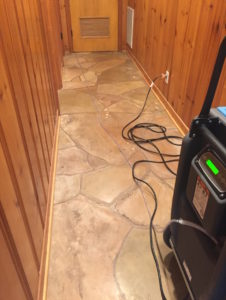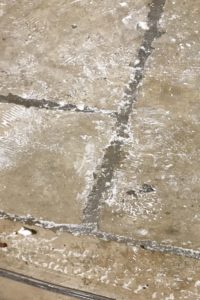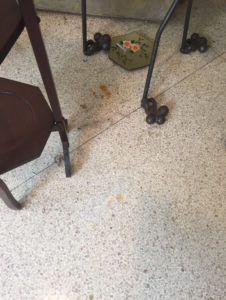First things first, make sure the water has drained from your home or building and use dehumidifiers to dry the floor as much as possible.

If you see white residue…
Once the floor is dry, you may see a white film appear on the floor; this white residue is most likely efflorescence/calcium residue.

According to the Natural Stone Institute: “Efflorescence is caused by water carrying soluble salts from below the surface of the stone. The salts are deposited and recrystallize upon evaporation of the water, leaving a powdery salt residue. If the installation is new, dust mop or vacuum the powder. Repeat as necessary as the stone dries out. Do not use water to remove the powder. If the problem persists, contact the contractor.”
…and by contractor, that would be us, International Stoneworks. Once the stone floor is as dry as it can get, we can come in and mechanically remove as much residue as possible with a brush. Then clean the area with a mild acid cleaner for slate and granite. For marble (and similar stones such as terrazzo and travertine), we clean with an alkaline stone cleaner, Lavenet.
If you see black or green residue…
This residue could be mold and mildew. If that is the case, please contact a mold remediation specialist first before refinishing the stone surface.
If you need cleaning, disinfecting, or stripping…
If the stone floor has a topical sealer coating on it, this sealer must be stripped off first in order to let the floor breath and the moisture evaporate.
If you need to disinfect your stone, please use a specialty cleaner that does not have acid in it such as Sani-Tyze. If you use an acidic cleaner on marble, terrazzo, travertine and limestone, you will acid-etch the floor.
If your tile and stone surface did not sustain water damage and you just want to clean the surface, sweep or vacuum, then use a neutral stone cleaner such as Lavenet.
If you have stains and discolorations…
After water damage to the stone, you may see darkening of the stone, this darkening is moisture that may just need time to evaporate. (If the stone floor has a coating on it, that coating needs to be stripped off in order to allow the moisture to evaporate).

Other stains may come from metal furniture, which may have left a rust stain. Rugs left on the stone floor may have also caused discoloration as well as other surface contaminants. Some stains may be too deep to remove; however, International Stoneworks may be able to poultice the stains out.
The Natural Stone Institute defines Poulticing as: “a process of stain removal. A chemical is used to loosen the stain with an absorbent media…” (such as a powder compound) “ to draw the stain out of the stone.”
Basically, what that means is we place a clay-like substance on the surface of the stain and leave it overnight. We return the next day to clean it off and hopefully the poultice has drawn out the stain.
If your stone has loss of shine…
Water damage can cause loss of shine to a stone floor. Professional restoration is needed once the floor is completely dried out in order to restore the polished finish.

Please note that water needs to be completely evaporated because moisture that continues to evaporate (from the bottom of the tile up) can etch the stone. Therefore, it is important not to prematurely polish the stone floor.
Professional honing and polishing is done using a fine abrasives (such as diamonds or a powder compound).
Dealing with water damage and flooding is heartbreaking and everyone here at International Stoneworks will do his and her best to help you through this difficult process.

